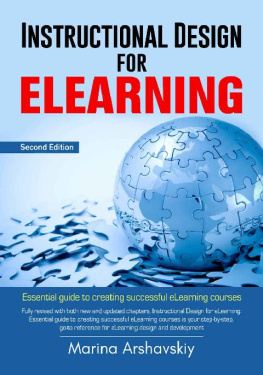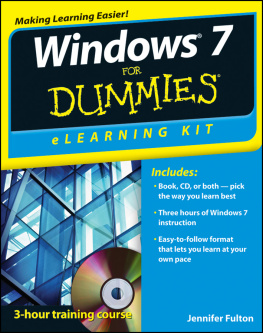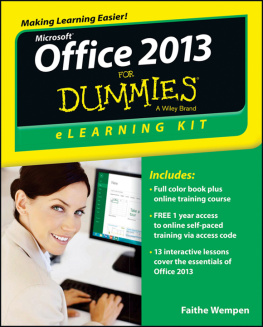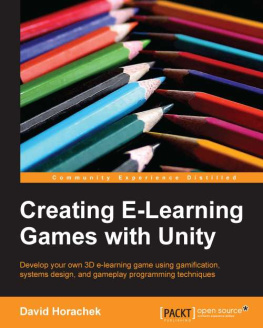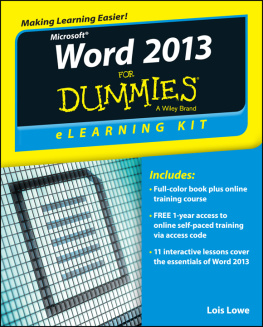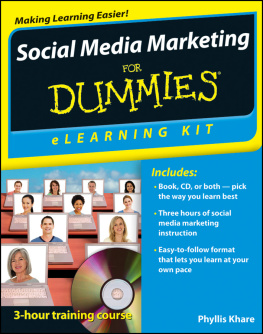Instructional Design for ELearning:
Essential guide to creating successful eLearning courses
Marina Arshavskiy
Second Edition Copyright 2017.
Marina Arshavskiy
www.yourelearningworld.com
All graphics in this book www.yourelearningworld.com
All rights reserved.
Trademarks
All brand names and product names used in this book are trademarks of their respective owners. The author is not associated with any product or vendor
in this book.
Table of Contents
Part I Basic Elements of Instructional Design
Part II - Designing Instructionally Sound ELearning Courses
Part III - Interactive Elements in the ELearning Course
Part IV - Advancing Your Skills
When I first entered the field of instructional design, I reviewed a lot of literature and read many books on the subject. However, I did not find a single guide that offered a combination of theoretical and practical information. As a result, I had to supplement the theoretical knowledge I gained from these books and other resources with on-the-job experience. Instructional Design for ELearning: Essential guide to creating successful eLearning courses combines both theoretical aspects of instructional systems design and practical information from field experience to help instructional designers create the most compelling and effective courses. In this text, you will find the best knowledge, skills, and tools I could glean from the market. In addition to introducing theory and providing practical advice, this book aims to offer best practices drawn from many years of personal experience in the field of learning and development.
The Instructional Design for eLearning book can serve as a desk guide for instructional designers at any level and of any professional experience. Whether you are an aspiring instructional designer looking for a career change, a novice instructional designer trying to learn the basics of eLearning course development, a seasoned instructional designer needing a desk reference guide, or a human resources professional designing professional development training programs for employees, this book is your new go-to resource. Even though it concentrates primarily on designing eLearning courses for the workplace, curriculum developers and instructional designers who create face-to-face training programs can also benefit from it, as it covers all the important elements of course design regardless of the context.
The book is divided into four sections:
Part I Basic Elements of Instructional Design
Part II Designing Instructionally Sound ELearning Courses
Part III Interactive Elements in ELearning Courses
Part IV Advancing Your Skills
This text includes 27 exercises that will help you put your newly acquired knowledge into practice. Even though the activities will not be graded or reviewed, they are an excellent way to recap the information from each chapter and put it into perspective. Note that the first exercise sets the foundation for your project but does not provide all the content needed to create a project. Therefore, to complete the exercises, you will have to make certain assumptions about the topic and its content. Alternatively, you can use a project you are currently working on or simply invent one to complete these exercises.
In this edition, I have added and rewritten content to keep it current. I also added new chapters that reflect the changes in the field of eLearning and instructional design in general. Additionally, I added quizzes to help readers assess their understanding of the content. More templates and case studies found in this edition should also help eLearning professionals succeed in the field of instructional design.
Read each chapter, apply the knowledge you gain, and enjoy your learning quest!
Part I - Basic Elements of
Instructional Design
If you think training is expensive, try ignorance.
Peter Drucker
Chapter 1: Instructional Design for ELearning
This chapter will cover:
- Definitions of instructional systems design, eLearning, and blended learning
- Definitions of CBT and WBT
- Advantages and disadvantages of eLearning
- Situations when eLearning is an appropriate solution

Instructional Systems Design
Instructional Systems Design, also known as ISD, is a systematic approach to creating effective courses. ISD is both a science and an arta science because it is based on learning theories, and an art because of the creativity involved in the design process. Furthermore, ISD is a tool that guides the structure of any course and promotes meaningful and active learning.
According to a renowned researcher and missionary, M. David Merrill, instructional design is the process of creating learning experiences that makes the acquisition of skill more appealing, effective, and efficient.
ISD follows standards similar to curriculum design; the chief difference being that ISD is mainly practiced in the workplace and concentrates on the how, while curriculum design applies to academic settings and concentrates on the why.
Even though there are many different approaches to designing courses, experienced instructional designers typically combine a variety of methods and incorporate technology and multimedia to enhance instruction.
Instructional designers are interested in knowing how people learn and retain information. According to Marc Rosenberg, a leader in the world of ISD training, performance is ultimately more important than training. There are many factors involved in creating eLearning materials that enable learners to retain information and, more importantly, transfer their newly acquired knowledge and skills to their jobs.
To people new to the field, ISD may appear easy. In reality, however, creating effective courses is rather complex. Skilled instructional designers focus on creating learning solutions that bring value to the organization by managing a projects time and cost. The success of their learning solution is measured by the performance improvement of their learners.
ELearning
ELearning is a form of learning conducted via internet, intranet, network, or CD-ROM. Successful eLearning courses are interactive, energetic, dynamic, and appealing to the learners auditory, visual, and tactile senses.
ELearning can be synchronous or asynchronous. Synchronous eLearning is done in real-time with a live instructor. The synchronous eLearning experience is similar to that of a regular classroom, except learners can take courses anywhere in the world as long as they have a computer, internet connection, and access to audio or video conferencing. Some of the tools associated with synchronous eLearning are instant messaging, application sharing, and polling. While synchronous eLearning has the value of having a real instructor and ability to communicate with other participants in the course, it requires learners to virtually attend the course at a specific time.
Many instructional designers and distance learning educators find synchronous eLearning challenging to design. Since there is no face-to-face communication, online teaching requires a lot of effort not only from the instructor, but also from the learner. To ensure that each learner receives individual attention, instructors must recognize various types of learners in the class and adjust to their unique needs. For instance, there are learners who are clearly leaders; they always post comments and responses to other peoples questions. There are also learners who always ask many questions, and expect to receive quick and thoughtful responses almost immediately. Furthermore, there are learners who take online learning very lightly, and do not participate in any discussions.

